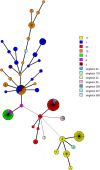CRISPR Typing Increases the Discriminatory Power of Streptococcus agalactiae Typing Methods
- PMID: 34349737
- PMCID: PMC8328194
- DOI: 10.3389/fmicb.2021.675597
CRISPR Typing Increases the Discriminatory Power of Streptococcus agalactiae Typing Methods
Abstract
We explored the relevance of a Clustered regularly interspaced short palindromic repeats (CRISPR)-based genotyping tool for Streptococcus agalactiae typing and we compared this method to current molecular methods [multi locus sequence typing (MLST) and capsular typing]. To this effect, we developed two CRISPR marker schemes (using 94 or 25 markers, respectively). Among the 255 S. agalactiae isolates tested, 229 CRISPR profiles were obtained. The 94 and 25 markers made it possible to efficiently separate isolates with a high diversity index (0.9947 and 0.9267, respectively), highlighting a high discriminatory power, superior to that of both capsular typing and MLST (diversity index of 0.9017 for MLST). This method has the advantage of being correlated with MLST [through analysis of the terminal direct repeat (TDR) and ancestral spacers] and to possess a high discriminatory power (through analysis of the leader-end spacers recently acquired, which are the witnesses of genetic mobile elements encountered by the bacteria). Furthermore, this "one-shot" approach presents the benefit of much-reduced time and cost in comparison with MLST. On the basis of these data, we propose that this method could become a reference method for group B Streptococcus (GBS) typing.
Keywords: CRISPR-Cas; Streptococcus agalactiae; group B Streptococcus; molecular subtyping; typing.
Copyright © 2021 Beauruelle, Treluyer, Pastuszka, Cochard, Lier, Mereghetti, Glaser, Poyart and Lanotte.
Conflict of interest statement
The authors declare that the research was conducted in the absence of any commercial or financial relationships that could be construed as a potential conflict of interest.
Figures


Similar articles
-
Group B Streptococcus Vaginal Carriage in Pregnant Women as Deciphered by Clustered Regularly Interspaced Short Palindromic Repeat Analysis.J Clin Microbiol. 2018 May 25;56(6):e01949-17. doi: 10.1128/JCM.01949-17. Print 2018 Jun. J Clin Microbiol. 2018. PMID: 29618502 Free PMC article.
-
New clustered regularly interspaced short palindromic repeat locus spacer pair typing method based on the newly incorporated spacer for Salmonella enterica.J Clin Microbiol. 2014 Aug;52(8):2955-62. doi: 10.1128/JCM.00696-14. Epub 2014 Jun 4. J Clin Microbiol. 2014. PMID: 24899040 Free PMC article.
-
CRISPR: A Useful Genetic Feature to Follow Vaginal Carriage of Group B Streptococcus.Front Microbiol. 2017 Oct 11;8:1981. doi: 10.3389/fmicb.2017.01981. eCollection 2017. Front Microbiol. 2017. PMID: 29075246 Free PMC article.
-
Analysis of direct repeats and spacers of CRISPR/Cas systems type I-F in Brazilian clinical strains of Pseudomonas aeruginosa.Mol Genet Genomics. 2019 Oct;294(5):1095-1105. doi: 10.1007/s00438-019-01575-7. Epub 2019 May 16. Mol Genet Genomics. 2019. PMID: 31098740 Review.
-
High Resolution Melting as a rapid, reliable, accurate and cost-effective emerging tool for genotyping pathogenic bacteria and enhancing molecular epidemiological surveillance: a comprehensive review of the literature.Ann Ig. 2017 Jul-Aug;29(4):293-316. doi: 10.7416/ai.2017.2153. Ann Ig. 2017. PMID: 28569339 Review.
Cited by
-
Virulence and pathogenicity of group B Streptococcus: Virulence factors and their roles in perinatal infection.Virulence. 2025 Dec;16(1):2451173. doi: 10.1080/21505594.2025.2451173. Epub 2025 Jan 23. Virulence. 2025. PMID: 39844743 Free PMC article. Review.
-
Group B Streptococcus CRISPR1 Typing of Maternal, Fetal, and Neonatal Infectious Disease Isolates Highlights the Importance of CC1 in In Utero Fetal Death.Microbiol Spectr. 2023 Aug 17;11(4):e0522122. doi: 10.1128/spectrum.05221-22. Epub 2023 Jun 21. Microbiol Spectr. 2023. PMID: 37341591 Free PMC article.
-
Determination of Technological Properties and CRISPR Profiles of Streptococcus thermophilus Isolates Obtained from Local Yogurt Samples.Microorganisms. 2024 Nov 25;12(12):2428. doi: 10.3390/microorganisms12122428. Microorganisms. 2024. PMID: 39770631 Free PMC article.
-
Group B Streptococcus Cas9 variants provide insight into programmable gene repression and CRISPR-Cas transcriptional effects.Commun Biol. 2023 Jun 9;6(1):620. doi: 10.1038/s42003-023-04994-w. Commun Biol. 2023. PMID: 37296208 Free PMC article.
-
Distribution, Diversity and Roles of CRISPR-Cas Systems in Human and Animal Pathogenic Streptococci.Front Microbiol. 2022 Jan 31;13:828031. doi: 10.3389/fmicb.2022.828031. eCollection 2022. Front Microbiol. 2022. PMID: 35173702 Free PMC article. Review.
References
-
- ANAES (2001). [Antenatal prevention of early neonatal bacterial infection (September 2001)]. J. Gynecol. Obstet. Biol. Reprod. 32 68–74. - PubMed
LinkOut - more resources
Full Text Sources

